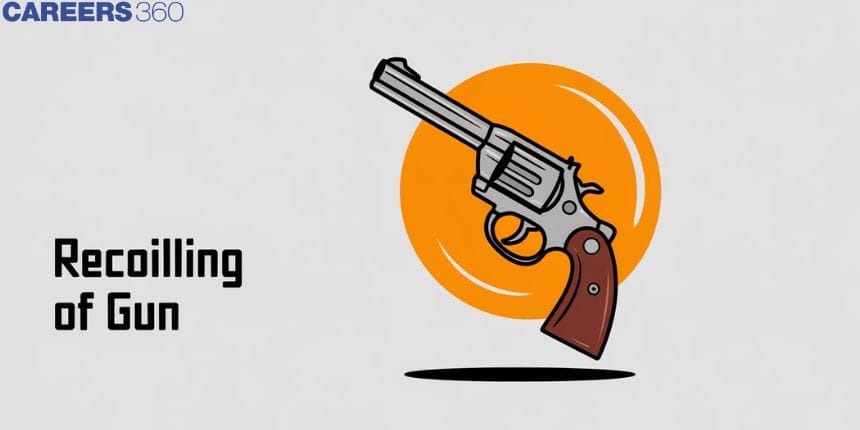Recoiling Of Gun
The recoiling of a gun is a fundamental concept in physics that illustrates Newton's Third Law of Motion: for every action, there is an equal and opposite reaction. When a gun is fired, the bullet is propelled forward by the explosive force of the gunpowder. Simultaneously, an equal force pushes the gun backwards, which is experienced as recoil by the shooter. This phenomenon can be observed in everyday life, such as when you push off a boat dock and the boat moves in the opposite direction, or when you jump off a skateboard, and the board moves backwards. Understanding the mechanics of recoil not only deepens our grasp of physics but also highlights the interconnectedness of actions and reactions in our daily experiences.
JEE Main/NEET 2027: Physics Important Formulas for Class 10
NEET 2025: Mock Test Series | Syllabus | High Scoring Topics | PYQs
JEE Main: Study Materials | High Scoring Topics | Preparation Guide
JEE Main: Syllabus | Sample Papers | Mock Tests | PYQs
- Recoiling of Gun
- Solved Examples Based on Recoiling of Gun
- Summary

Recoiling of Gun
Let us consider a case of a gun held at rest. Let the mass of the gun be mg, the mass of the bullet be mb, the velocity of the bullet after firing the gun be Vb and, the recoil velocity of the gun be Vg.
Assuming the net external force acting on the bullet and gun system is zero.
$\Rightarrow F_{\text {ext }}=0$
Since the net external force on the gun and bullet system is zero the total momentum of the system will be constant.
Assuming the gun and bullet to be at rest initially, Initial momentum=0
Final momentum $=m_b V_b+m_g V_g$
So from momentum conservation, we get
$\begin{aligned} & 0=m_b \overrightarrow{V_b}+m_g \overrightarrow{V_g} \\ & \Rightarrow \overrightarrow{V_G}=-\frac{m_B}{m_G} \times \overrightarrow{V_B}\end{aligned}$ The -ve sign indicates that $\overrightarrow{V_G}$ is opposite to that of the velocity of the bullet.
The higher the mass of the gun lesser be recoil velocity i.e $\vec{V}_G \propto \frac{1}{m_G}$
When the body of the shooter and the gun behave as one body/system
Then $\quad \overrightarrow{V_G} \propto \frac{1}{m_G+m_{\operatorname{man}}}$
where $m_{\text {man }} \rightarrow$ mass of person holding gun
If n bullet each of mass m is fired per unit time from a gun
Then
$\begin{aligned} & F=V_{\text {rel }}\left(\frac{d m}{d t}\right)=V(\mathrm{mn}) \\ & F=m n v \\ & F=\text { force required to hold the gun } \\ & n=\text { no. of bullets }\end{aligned}$
Recommended Topic Video
Solved Examples Based on Recoiling of Gun
Example 1: A disc of mass 20 g is kept floating horizontally by firing 10 bullets per second against it from below. The bullets strike the disc normally and rebound downwards with the same speed. If the mass of each bullet is 10 g, the velocity with which the marbles are striking the disc is (g=9.8m/s2)
1) 9.8
2) 98
3) 0.98
4) 48
Solution:

$\begin{aligned} & m_1 g=\frac{n \times(m \Delta v)}{\Delta t} \\ & 20 \times g=\frac{10 \times(10 \times 2 v)}{1} \\ & v=0.98 \mathrm{~m} / \mathrm{s}^2\end{aligned}$
Hence, the answer is the option (3).
Example 2: A bullet of '4g' mass is fired from a gun of mass 4 kg. If the bullet moves with the muzzle speed of $50 \mathrm{~ms}^{-1}$, the impulse imparted to the gun and the velocity of recoil of the gun are :
1) $0.4 \mathrm{~kg} \mathrm{~ms}^{-1}, 0.1 \mathrm{~ms}^{-1}$
2) $0.2 \mathrm{~kg} \mathrm{~ms}^{-1}, 0.05 \mathrm{~ms}^{-1}$
3) $0.2 \mathrm{~kg} \mathrm{~ms}^{-1}, 0.1 \mathrm{~ms}^{-1}$
4) $0.4 \mathrm{~kg} \mathrm{~ms}^{-1}, 0.05 \mathrm{~ms}^{-1}$
Solution:
system $\rightarrow$ Gun + bullet
$
\begin{aligned}
& \left(P_i\right)_{\text {system }}=\left(P_f\right)_{\text {system }} \\
& 0=m v_1+m_2 v_2 \\
& 0=4 \times 10^3 \times 50+4 \times v_2 \\
& v_2=-50 \times 10^{-3}=-0.05 \mathrm{~m} / \mathrm{s}
\end{aligned}
$
A negative sign here implies that the direction of motion of the gun is opposite to the direction of the bullet
$
\begin{aligned}
\text { Impulse imparted to the gun } & =\Delta P_{\text {Gun }}=\left(P_f\right)_{G u n}-\left(P_i\right)_{\text {Gun }} \\
& =\left(m_2 V_2\right)-0 \\
& =4 \times 50 \times 10^{-3} \\
& =0.2 \mathrm{~kg} \mathrm{~m} / \mathrm{s}
\end{aligned}
$
Hence, the answer is the option (2).
Example 3: A bullet of mass 10 g is fired by a gun of mass 10 kg with a velocity of 200 m /s then find the velocity of the gun ( in m /s) :
1) 0.2
2) -0.4
3) 0.2
4) -1
Solution :
Given :
$
\begin{aligned}
& M=10 \mathrm{~g}=10000 \mathrm{~kg} \\
& m=10 \mathrm{~kg} \\
& v=200 \mathrm{~m} / \mathrm{s}
\end{aligned}
$
Apply the law of conservation of momentum
$
\begin{aligned}
& p_i=p_f \\
& (m+M)\left(-v_r\right)=m v \\
& (10000+10)\left(-v_r\right)=10 \times 200 \\
& \therefore v_r=-0.2 \mathrm{~m} / \mathrm{s}
\end{aligned}
$
Hence, the answer is the option (1).
Example 4: A machine gun of mass $10 \mathrm{~kg}_{\text {fires }} 20 \mathrm{~g}$ bullets at the rate of 180 bullets per minute with a speed of $100 \mathrm{~m} \mathrm{~s}^{-1}$ each. The recoil velocity of the gun is
1) $1.5 \mathrm{~m} / \mathrm{s}$
2) $0.6 \mathrm{~m} / \mathrm{s}$
3) $2.5 \mathrm{~m} / \mathrm{s}$
4) $0.02 \mathrm{~m} / \mathrm{s}$
Solution:
$\begin{aligned} & 20 \times 10^{-3} \times \frac{180}{60} \times 100=10 \mathrm{~V} \\ & \mathrm{~V}=0.6 \mathrm{~ms}^{-1}\end{aligned}$
Hence, the answer is the option (2).
Summary
The recoiling of a gun demonstrates Newton's Third Law of Motion, where the gun moves backwards as the bullet is propelled forward. The magnitude of recoil depends on the mass of the gun and bullet, with a heavier gun resulting in lesser recoil. This concept is crucial in understanding the conservation of momentum, as illustrated through various examples, where the recoil velocity of the gun is calculated based on the bullet's mass and velocity.
Also Read
05 Feb'25 04:38 PM
11 Jan'25 03:12 PM
03 Dec'24 04:00 AM
03 Dec'24 03:48 AM
29 Nov'24 11:10 AM
28 Nov'24 01:12 AM
27 Nov'24 11:57 PM
27 Nov'24 02:41 PM
27 Nov'24 02:15 PM
26 Nov'24 03:04 PM
